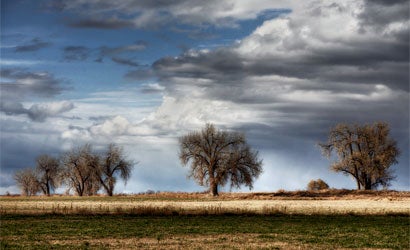You Can Do It: Sky High
How to make magic with a RAW image, polarizer, and High Dynamic Range software.

In Colorado, we have amazing skies, constantly moving and changing. I’ve learned to read them, and can often see a great sunset coming, sometimes hours in advance. Telltale signs: nice light; a clear, unhazy atmosphere; and usually the kind of blustery wind kicked up when two colliding weather fronts butt heads. This wind usually means dramatic cloudscapes — and wonderful sunsets.
All the ingredients were in place one afternoon last November, so I jumped into my car and headed out toward a little pond for reflections of the setting sun. Suddenly, the sky opened, and I saw these trees, sunlit, with the foreground in shadow.
I pulled over, but it was almost too windy to step out of the car. A tripod would’ve blown over. So I stayed in the vehicle, turned off the engine (to avoid shake), rolled down a window, and grabbed my Canon EO S 5D. As always when shooting cloudscapes, I threaded a Tiffen circular polarizer onto the lens (a 70-200mm f/2.8L IS zoom) to bump up overall contrast and saturate the blues. I popped off a few shots (1/800 sec at f/8 and ISO 100). This was the best.
Back at home, I loaded the file into Adobe Photoshop 7.0, and started to play. I always shoot RAW and have since day one. From a single RAW file, I used HDR Soft’s Photomatix (www.hdrsoft.com) plug-in to pull extra highlight and shadow detail from the RAW file and incorporate it into a new High Dynamic Range (HDR) image. Although I was pleased with the added detail in the brightly lit dirt road and darker trees, I wasn’t done yet.
My next step was more daring. I started with a Curves Adjustment Layer and bumped up the saturation of the HDR image a bit (+5). Then I converted it to a high-contrast blackand- white using Nik’s infrared blackand- white filter (www.niksoftware. com) at its Number Two setting.
The monochrome infrared version had a nice overall glow, but I missed the color. So I tried something new, and faded down the b&w layer to almost 20%, until I got the image on the previous page. It reflects a bit of the infrared glow — just enough to make a difference. A few clouds were too bright, so I added some tone using the Burn tool.
Want to try this? Get out and do it! We all know when the best light is. It’s just a matter of getting up early or staying out late enough to capture it. Digital gives us unlimited possibilities, both in the number of shots we can take without breaking the bank and in what we can do with them.
By the way, I never got my sunset that afternoon. The storm you see brewing on the right rolled in to darken the sky completely. I’m not complaining, though.
–A.J. Schroetlin lives in Fort Collins, CO. You can see more of his work at www.aschroetlinimages.com.